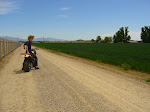Spanish Harlem, also known as El Barrio and East Harlem, is a predominantly low-income neighborhood in the northeastern part of the borough of Manhattan. The neighborhood boundaries are the Harlem River to the north, the East River to the east, East 96th Street to the south, and 5th Avenue to the west. The primary business hub of Spanish Harlem is 116th street where local taco makers sit in little stands outside Taco Bells. The area is patrolled by both the 23rd Precinct located at 162 East 102nd Street and the 25th Precinct located at 120 East 119th Street.
Manhattan Community District 11, which covers Spanish Harlem and a part of the Upper East Side, has a population of 117,743 as of the 2000 US census. Over 25% of the population resides in units managed by the NYCHA (New York City Housing Authority). It also has one of the highest concentrations of Puerto Ricans in all of New York City. The vast majority of units in Spanish Harlem are renter occupied.
"Residents of East and Central Harlem are largely limited to fast food restaurants and small bodegas as food sources, which primarily carry packaged foods and have limited fresh produce options. Area residents have also identified the need for more fitness options, particularly for youth and seniors. These inequities have resulted in health disparities and high rates of obesity." -Kellogg Foundation-
Access to healthy food causes serious hardships to citizens of Spanish Harlem, a neighborhood considered to be a food desert. Spanish Harlem is an area of the city with the highest levels of diet-related diseases due to limited opportunities for citizens to purchase fresh foods. Supermarkets in Harlem are 30 percent less common than other similar residential areas, and only 3 percent of bodegas in Harlem carry leafy green vegetables as compared to 20 percent on the Upper East Side.
Social problems associated with poverty from crime to drug addiction have also affected the area for some time. Violent crime remains an obstacle to community security, but crime rates have dropped significantly—around 68% over the past 15 years. There are still drug dealers on the corners and outside the bodegas, but they are “the good kind,” and will offer you weed by strand or brand name instead of just weed, green, or herb.
Spanish Harlem has significantly higher drop out rates and incidents of violence in its schools. In some schools, students must pass through metal detectors and swipe ID cards to enter the buildings. Other problems in local schools include low test scores and high truancy rates.
125th street has changed ratically in the last few years where stores like American Apparel, H&M, and Staples have popped up in recent years. Some residents feel the area should be labeled "SpaHa" to point out emerging similarities with SoHo and TriBeCa. Of course, this is to many long-term residences dislike as gentrification has pushed rent up significantly and many real estate companies are buying up historic buildings only to demolish them and build new modern condos.
There are twenty-four NYCHA developments located in Spanish Harlem.
-1. 335 East 111th Street; one, 6-story building.
. East 120th Street Rehab; one, 6-story rehabilitated tenement building.
. East River Houses; ten buildings, 6, 10 and 11-stories tall.
. Edward Corsi Houses; one, 16-story building.
. Gaylord White Houses; one, 20-story building.
. George Washington Carver Houses; 13 buildings, 6 and 15-stories tall.
. Governor Dewitt Clinton Houses; six buildings, 9 and 18-stories tall.
. Jackie Robinson Houses; one, 8-story building.
. James Weldon Johnson; ten, 14-story buildings.
. Lehman Village; four, 20-story buildings.
. Lexington Houses; four, 14-story buildings.
. Metro North Plaza; three buildings, 7, 8, and 11-stories tall.
. Metro North Rehab; seventeen, 6-story rehabilitated tenement buildings.
. Milbank-Frawley; two rehabilitated tenement buildings 5 and 6-stories tall.
. Morris Park Senior Citizens Home; one, 9-story rehabilitated building.
. Park Avenue-East 122nd, 123rd Streets; two, 6-story buildings.
. President Abraham Lincoln; fourteen buildings, 6 and 14-stories tall.
. President George Washington Houses; fourteen buildings, 12 and 14-stories tall.
. President Thomas Jefferson Houses; eighteen buildings, 7, 13 and 14-stories tall.
. President Woodrow Wilson Houses; three, 20-story buildings.
. Senator Robert A. Taft; nine, 19-story buildings.
. Senator Robert F. Wagner, Sr.; twenty-two buildings, 7 and 16-stories tall.


No comments:
Post a Comment